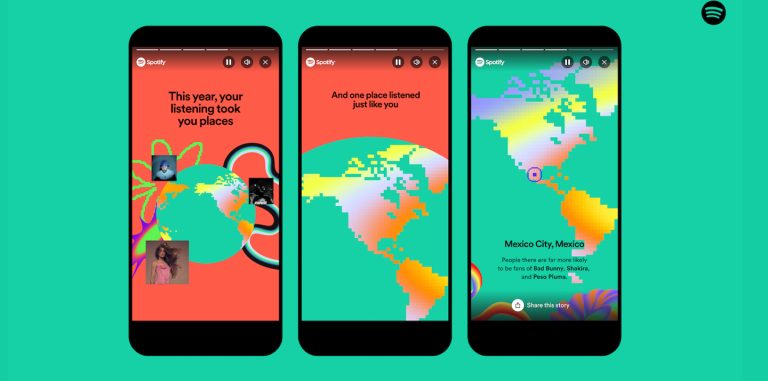
While consistency is a key part of seeing great marketing results, the world of digital marketing is always evolving. So, if you want to remain competitive and relevant, it’s time to get clued up on what’s new in marketing for 2024.
From understanding what type of content audiences actually want to see next year, to understanding smarter AI tactics, here’s all you need to know.
1. Increased Emphasis on Personalised Content
Personalised content will be an important part of marketing development, as customers seek more targeted and relevant communication. It’s about making individuals feel like, well, individuals!
Customer profiling can be a valuable tool in understanding who your customers are, but in 2024, it’s time to leverage this information to deliver bespoke content. Utilising AI in this process can help you collect, analyse and understand the data you have available, such as purchase history, age, and buying behaviours. This enables you to offer more effective personalisation or make predictions about what they might be considering in the future.
Perhaps the most helpful use of AI in personalisation is segmentation since AI algorithms can quickly analyse large datasets, and identify patterns or trends that could otherwise be overlooked. With a better understanding of each audience, you can then leverage tools like ChatGPT to generate personalised content for landing pages, marketing materials, emails, or social media posts. This is great for crafting a more relevant and engaging communication strategy.

Customers want their needs to be recognised. In the long run, you can improve customer loyalty, engagement, and satisfaction just by personalising your messaging. Here’s a great example on Amazon of personalisation through cross-selling. On this product page selling gardening gloves, they’ve also included a useful ‘frequently bought together’ section that includes a related item they might also need, in this case, secateurs, to encourage additional sales.

Don’t forget about hyper personalisation too (think Spotify Wrapped or Coca-Cola bottles with your name on) where each user is served up a story where they are the main character!
How to personalise your content:
- Customise email campaigns: Try using personalised subject lines, content, and recommendations based on customer preferences and behavior. You might notice an increase in your email open rates and reach other KPIs easier such as more sales or website traffic as customers feel understood.
- Provide tailored offers: Customers love receiving special offers and discounts based on their preferences. Use information such as their purchase history to deliver personalised recommendations of products they might like, or discounts off items they regularly purchase — who doesn’t want £5 off their next order?
- Offer targeted resources post-sale: Send valuable (and targeted) content straight from your blog directly to your customers to enhance their purchase. For example, a specialised running shoe company could personalise their post-purchase communication with an email like this: “Hello [name], we hope your running journey is off to a great start! Since you’ve just purchased our beginner running shoes, we thought you might appreciate our guide on breaking in your new running shoes! [insert blog link]” This approach acknowledges them as a unique customer, in this case, a beginner runner, and shows that you’re invested in their post-purchase satisfaction.
2. Personalisation Boosted by AI Technology
AI is already changing the world of marketing, but in 2024, its ability to aid in personalisation will be refined even further. Of course, we’re not advocating for AI to replace human input altogether, but instead, harnessing its abilities to interpret large amounts of data.
There are so many factors to consider in personalisation, and sorting all of these data points manually can, to put it bluntly, be rather tiresome. The solution? Use AI to automate the process. AI can predict future customer preferences, identify patterns, and increase workflow efficiency across the board.
How to use AI in personalisation:
Use predictive personalisation: AI can predict which content or products a user might be interested in next. By considering historical data and current behavior, AI algorithms offer personalised recommendations before the user explicitly expresses a need.
Use AI to delve into specific areas of interest: AI can be used to identify general and more detailed patterns within segmented groups, which can help you nail your targeting.
For example, a more general finding might be: “After purchasing their first pair of trainers, newer customers tend also to purchase a running vest” whereas a more specific finding could be: “Of the ‘new customers’ group, those ages 18-25 are more likely to redeem a personalised voucher code on a running vest within the next 3 months.” With this in mind, you can understand how to market to these groups more effectively.
3. Embracing Live Streaming Strategies
Have you ever stumbled across a live stream on TikTok and before you knew it you’ve been watching for hours? No? Just us then! While short-form video is still thriving, more and more businesses will likely tap into the popularity of live streaming.
TikTok lives are a great example of how creators and businesses capture an audience. Creator-led live streams can be anything from ‘get ready with me’ style streams, live cooking tutorials, or chatty Q&A sessions, all of which allow their followers and new viewers to communicate with them in real time.
Where things get interesting is when you add concepts such as TikTok shop live streams into the mix! Businesses with a TikTok shop can host their own live streams, where they showcase products directly available for purchase during the session or collaborate with influencers on sponsored live streams.

Image credit: shop.TikTok
Brands like Made by Mitchell and P Louise Cosmetics have grown dramatically, thanks to TikTok, with a loyal following that consistently sells out their products! And it’s not just ecommerce brands that can benefit from live video content. Even non-profits like Children in Need have used live streaming to generate more awareness and donations during their appeals! All in all, live streaming is a great way of increasing brand visibility, understanding customer demands, and getting to know your target audience.
How to embrace live streaming:
Experiment with different types of streaming: The key to a successful live stream, whether that’s gaining high views or generating more sales, is learning what type of live stream content resonates with your audience. If you’re a makeup brand, then try running a live makeup tutorial featuring your products, or if you’re selling loungewear, host a live try-on session of your newest range. The possibilities are endless!
Identify relevant creators to collaborate with: Creator-led live streaming can help you reach new audiences and convert them into customers. Start by identifying creators within your niche. Choosing influencers with a substantial amount of followers can be beneficial (although be prepared to increase your budget!), but don’t overlook the value of micro-influencers. They are often viewed as more trustworthy and authentic compared to bigger influencers, making them ideal vehicles for fostering brand evangelism.
4. Harnessing the Power of Social Listening
Social listening is set to become even more important next year. It’s all about remaining current and putting your spin on the latest trends and topics, as people seek to be a part of what’s new.
You can practice social listening by simply observing the conversations people are having on social media, and TikTok is particularly great for this. Nowadays, many hyper-focused trends, topics, and products gain traction from TikTok — take the Stanley Cup hype or girl math trend for example! These miniature cultural phenomena can happen in a flash, but if you catch them while they’re still hot, you can transmute some of the buzz into brand awareness by creating content that references, remixes, or critiques its source material.
Alongside using social media, tools like Exploding Topics can provide real-time data and insights into what people are currently interested in. Don’t expect to garner the same results as you would from manually trawling through TikTok — hard work pays off in this regard — but such tools are useful for a broad overview of the topics that are gaining traction online.
How to nail social listening:
Engage with your audience: Social listening isn’t just about observation; it’s also about active engagement. Authenticity matters — audiences have grown wise to brands exploiting trends, and the best way to combat this is to humanise your business by diving headfirst into the comments section. Sure, you might receive a little push-back now and then — receiving the ‘silence brand’ treatment is almost a badge of honour at this point — but don’t let this discourage you! Contribute to the conversation, throw in some humour, and if you’re feeling particularly bold, tag your competitors and spark a little brand beef.
Have fun with your findings: Being in tune with what people are currently hyped about can push your brand to the forefront when you join in. Take EasyJet’s TikTok videos for example. They’re not afraid to have fun, and they’re swift to jump on trends while they’re still peaking — take their recent tube-girl inspired videos; prime examples of social listening done right.
5. Discontinuing Less Engaging Social Channels
2024 should be the year that you drop your underperforming social media channels. Instead of spreading yourself thin across numerous platforms, it’s more beneficial to concentrate on a select few, where you can garner the engagement your brand deserves.
Start 2024 by auditing your social channels. Consider which channels are the most effective for you in line with your goals, and which channels simply aren’t working as well. You can do this by looking at your analytics and conversions to identify which channels are stagnant.
Think carefully, as there might be opportunities to revive a dead channel with a fresh strategy, but if you’ve noticed a decline for a while despite multiple attempts at making it work, your energy may be better spent elsewhere…
How to identify dead social channels:
Check out your audience growth: Analyse the growth of your audience on each social channel. A lack of new followers or a diminishing audience size compared to other channels suggests that the channel may not be resonating with your target demographic.
Conduct competitor analysis: Conduct a competitive analysis to see how your competitors are doing on different social channels. If your competitors are abandoning a particular platform or gaining traction elsewhere, it could provide insights into where your focus should be.
6. Creating Raw and Authentic Content
There’s something incredibly refreshing about seeing brands post raw, unfiltered content on social media. After over a decade of businesses refining and polishing their online personas, such content can provide a welcome change from the glossy, over-produced uploads we’ve all grown so accustomed to.
We’ve said it before, and we’ll continue to say it until we’re blue in the face: authenticity is paramount on social media. Creating raw and authentic content that shows the human side of your brand is what people crave. But let’s be clear — this isn’t to say that your entire content strategy should be improvised, rather, it simply means embracing transparency.
Start by providing a glimpse behind the scenes of your business. This could include showcasing the production process, introducing team members, or offering a tour of your workspace. Or, how about user-generated content? This often feels more authentic as it comes directly from your customers’ experiences and can prove a potent method for building trust and credibility.
How to embrace authentic content creation:
Live streaming: Live streaming on platforms like Instagram or TikTok can provide an authentic and spontaneous feel as they’re unedited and allow for real-time interaction with your audience.
Give creative freedom to influencers: When working with influencers, it’s fine to provide rough guidelines on the kind of content you’re looking for, such as a video tutorial or a feature in a vlog. However, allowing them the flexibility to bring their unique perspectives to the collaboration ensures that the content feels genuine to their style. If something feels disjointed or overproduced, audiences will pick up on it, and it could backfire on you!
7. Integrating SEO into Social Media Strategies
Did you know that around 40% of young adults (aged 18-24) are using social media like a search engine? That means that instead of heading to Google to look for new lunch spots in their city, they’re heading to channels like TikTok for their answers! So, for 2024 be sure to focus on social media SEO!
Optimising your content is crucial not just for the internal algorithms of each platform, but also for search engines, considering that social media profiles and content are visible in the SERPs. Conducting keyword research is essential for both aspects of social media SEO. To achieve this, emulate how users might treat a specific channel as a search engine.
Consider the search term ‘easy meals,’ for instance. Type this into Instagram and check the hashtag section to discover related search terms that could be incorporated into your caption or hashtag. Similarly, on TikTok, the ‘others searched for’ section provides insights on related searches that could help optimise your posts. Lastly, don’t forget to analyse the profiles of the top search results. What information do they feature in their bios?

Captions are a vital area to focus on. Strategically including these keywords in your captions can help with rankings, but it’s equally important for your captions to provide valuable details for your audience, too — in this case, adding the recipe steps or top cooking tips, for example. Essentially, craft your captions for your audience first and foremost, and then tweak them for SEO purposes.
How to improve your social media SEO:
Assess the type of content that’s ranking well: To maintain competitiveness in social media rankings, a useful strategy is to analyse top-performing content. When you have a content idea, search for it across multiple platforms and pay attention to how titles and captions are structured, as well as the style of content. You’ll have a better idea of which features help secure high rankings, which you can then incorporate into your content.
Optimise your profiles: Complete your profiles; leaving them empty confuses Google and makes you look lazy — or worse, untrustworthy —to your audience. Opt for profile names, bios, and descriptions that include keywords to highlight your focus. For instance, if someone searches for ‘Bristol teeth whitening,’ having this phrase in your bio boosts the chances of your profile popping up in their search results.
And that’s a wrap! Now it’s time to start 2024 in the best position for digital growth. Incorporate these 7 marketing trends into your strategy and give your marketing approach a new lease of life.
Remember, if you need help with SEO, content, or link building, get in touch with our digital marketing experts and make 2024 the year you go above and beyond your goals!
